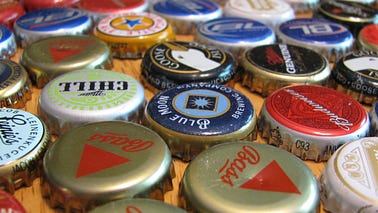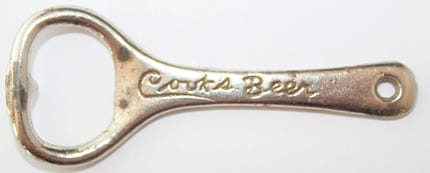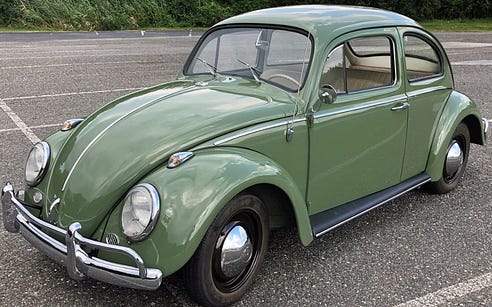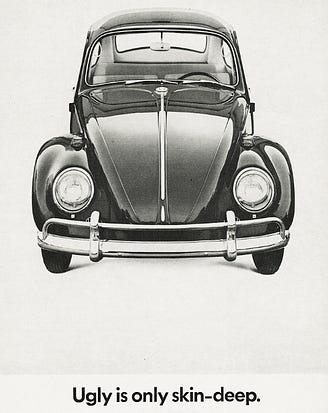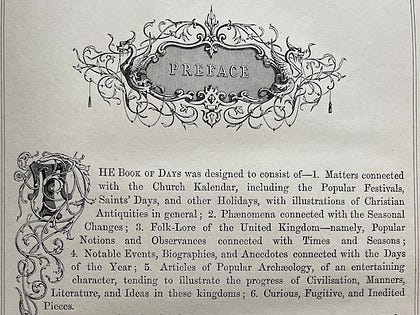Feake Hills, Crooked Waters - The issue with imagining
Open in browser
Something for Nothing; Super!Most glass beverage bottles nowadays are molded with screw threads so you can twist the metal cap off with your fingers. But some — particularly beer bottles — still come with metal caps crimped onto the top. Those caps have a name: they’re “crown corks.” They were invented in 1892 in Baltimore, and not only represented a new way to seal bottles, but were also the first widely successful product that you just threw away. the crown cork would generally get bent when taking it off, and couldn’t be reused. Even if you take one off very carefully, it’s nearly impossible to put it back on the bottle. Crown corks were an immediate hit and led to the rise of the Crown Cork and Seal Company — which still exists. And speaking of disposable products, another one is the disposable razor blade, which was developed by King Gillette. He got the idea when he was employed by the Crown Cork and Seal Company as a salesman. King Gillette had some unusual ideas for a rich industrialist — he thought all businesses should be consolidated into just one, which would be owned by the general public. He actually started that company, called the World Corporation, tried to hire Theodore Roosevelt to be the CEO, and offered him a salary of a million dollars (back when that was real money, too). That idea never went anywhere, but he had another idea that had an interesting offshoot: he thought everyone in the US should settle in one single huge city. It would be powered by electricity produced by Niagara Falls, and would be called “Metropolis.” Gillette wrote several books trying to popularize his ideas, and since his portrait appeared on every package of “safety razor blades”, which were nationally popular, he sold quite a few books. So some of his ideas may have been floating around in the national imagination in the 1930s, when Superman comics appeared. Superman was based in Metropolis, which was located in New York state, within reach of electrical power from Niagara Falls. As everyone knows, Superman has superhuman strength and so would be easily able to replace a used crown cork on a bottle, crimping it shut with his super Kryptonian fingers. Does Superman drink beer, by the way? Does it affect him? Does Superman even eat? Is there a bathroom in his Fortress of Solitude? Anyway, “Crimp” comes from the Old English word “crump”, which meant to fold or bend. In the 1700s it mostly was used to refer to hair (“Would you like your hair crimped, sir?” — 1786), but by the 1800s it referred to attaching metal by folding it in a particular way: “The cylinders were crimped on to the bases of dummy Pettman's percussion fuzes.” (1875). So the word was ready and waiting when crown corks came along. Not having super Kryptonian fingers, most people need a tool to remove a crown cork from a bottle. The tool is prosaically called a “bottle opener”, but by the middle of the 20th century it was widely recognized as a “church key.” Nobody knows where the name originated, but the tool was often stamped or enameled with ornate logos and given away. It was an early form of “freebie advertising”, or “freebie marketing”, where you give away one thing (a bottle opener) to stimulate sales of your real products (bottles of beer). One of the first and most successful practitioners of freebie marketing? King Gillette, who gave away the razors in order to sell the blades. But you know, there is one thing I’ve always wondered: does Superman need to shave? If he does…how does he do it? A regular disposable razor blade wouldn’t cut his super whiskers, would it? Tales from the ForestRaccoon and Hare were strolling along a pleasant forest path on their way to visit Beaver. As they chatted, Beaver’s book collection came up. “Beaver is my friend,” said Hare, “but I just don’t understand why he likes books.” “They’re made of paper,” said Raccoon. “And paper is made of wood.” “Yes…” said Hare dubiously, wondering what Raccoon was getting at. “What does Beaver eat?” asked Raccoon. “Wood,” she said, answering her own question. “So Beaver likes to collect books because it’s like having a huge pantry, just in case you feel peckish.” “Beaver would never EAT a book,” said Hare firmly. “I’m sure of it.” “He might if he didn’t live in the middle of a whopping great forest,” said Raccoon. “Because what is a forest made of? Trees. And what are trees made of? Books. Er, no, I mean wood. So Beaver doesn’t need to dig into his pantry of books. He’s probably just worried. About what, you ask?” “I didn’t ask anything,” said Hare. “And Raccoon, why are you talking like this; posing a question and then answering it yourself? You’ve never talked like that before.” “I woke up this morning feeling like I might just unexpectedly wind up as a character in a story,” said Raccoon. “A story that wasn’t planned for, until someone besides the author — maybe a family member or something of the sort — had the idea. They probably said something like ‘you know what the best kinds of stories are? The ones with raccoons in them,’ and the author naturally agreed. And so here I am.” “You mean you think you’re in a story right now?” asked Hare. “Is it possible?” said Raccoon. “Yes”, she said. “Stop doing that,” said Hare, “It’s annoying.” “I’m trying to become a memorable character with a characteristic quirk,” said Raccoon. “Everybody likes them the best. You know, like Linus with his blanket, or Pac Man with those cherries, or Captain Ahab with his pet fish.” “I think it was a whale, not a fish,” said Hare, “and possibly not a pet.” “In that case, think about Eeyore and how he’s always gloomy,” said Raccoon. “Could I become the character who always answers her own questions? I think I could! Just picture it, Hare, some little urchin toddles in saying ‘mummie, mummie, I want to hear the story about the cute, adorable animal who always answers her own questions.’” “Leaving aside your unfathomable conjecture regarding the potential of your appearance in fiction,” said Hare, “don’t you think, Raccoon, that this little urchin is more likely to remember that Raccoons look like they’re wearing masks and have rings around their tails?” “Maybe it’s not a picture book,” said Raccoon. “Not every medium is amenable to illustration. And is every author also an illustrator? I think not!” “I see what you did there,” said Hare dryly. “But anyway, tell me more about this ‘author’ you’ve dreamed up.” “Well there doesn’t HAVE to be an author,” said Raccoon. “Even some of Beaver’s books don’t have authors.” “Are you saying,” said Hare, stopping and turning to look straight at Raccoon, “that some books aren’t written by anyone?” “That’s what ‘anonymous’ means,” said Raccoon. “Er, that is, what does ‘anonymous’ mean? It means ‘nobody’. Sorry, I’m still getting the hang of my cute affectation.” “Number one,” said Hare, counting off on his toes, “it is the opposite of cute; you have NO IDEA how annoying it is. And number two, if nobody writes a book, how can there be a book?” “Do I know all the answers?” started Raccoon… “NO!” shouted Hare before Raccoon could continue. “You clearly don’t. In fact, I’m not sure you even have a good grasp on the questions, Raccoon.” “When we get to Beaver’s house,” said Raccoon, “you just look in his library. Some of the books say ‘anonymous’ where the author’s name ought to be. That means ‘nobody’, and the author is the one who writes the book. So does that mean…” “Stop. Doing. That.” said Hare. “I just think it would be fun to be famous,” said Raccoon. “By being the memorable character with the endearing characteristic?” asked Hare. “Yes,” said Raccoon, “exactly like that.” “So if there IS a character in a story who talks like that,” said Hare, “that character would probably be a villain, on account of annoying everyone so much. And even so, why would that character make YOU famous? Even if everybody liked the character, that’s not the same as them liking you, is it?” “Here is Beaver’s house,” said Raccoon. “You go ahead in, Hare, I’m just going to sign some autographs for my fans.” “What fans?” asked Hare. Raccoon pointed. Lined up on the banks of Beaver’s pond were dozens of people, mostly wearing brightly colored t-shirts emblazoned with the slogan “Do I love Raccoon? Yes!” None of the t-shirts, though, had a picture of Raccoon. “Um…” said Hare. “Who are those people? Why do they want your autograph? And for that matter, what is an autograph anyway?” “They’re my fans,” explained Raccoon, heading for the crowd, who began to cheer. “Am I famous, Hare? Yes!” Hare smacked his forehead and went to knock on Beaver’s door before the author — if there was one — could revise anything. ReimaginationAs an artifact of the 20th Century, the VW Beetle is many things — iconic, beloved, remembered, and weird. It started out as an idea sponsored by, of all people, Adolf Hitler (who is iconic and remembered but not beloved). It was a “car for the people”, which is even where the name “Volkswagen” comes from. and “the people” at the time were natives of Nazi Germany. Germany at the time — this was the 1930s — was impoverished on purpose; the countries that won World War I imposed sanctions on Germany for its part in that war. German people couldn’t afford cars, and for that matter couldn’t afford much. Hitler saw how the automobile was mobilizing Americans even in a global depression, and thought that would benefit Germans as well. So he sponsored a sort of competition for the design of an inexpensive, reliable car that could be built and used in Germany, thus stimulating the economy. The Beetle won. It was, for its entire (very long) existence, a cheap car. No frills. Things that other cars had didn’t arrive on VWs until later — things like gas gauges, turn signals, radiators (VW engines were air-cooled), and the like. The materials used to build VWs were nothing special, but somehow the design itself made the cars less susceptible to rust than many others. The Beetle existed before World War II, and there were some variants made for the German war effort — most memorable was the “kubelwagen.” So as a German product, and a contributor to the war, you’d think Americans would, by default, hate and resent the things. Their ideas about VWs would include Hitler and the brutalities of the war. But that didn’t happen. Instead, VWs were imported to the US after WWII and became strangely successful, even in an era when efficiency was ignored and gasoline cost pennies per gallon. Then when the 1960s came along and an anti-establishment counterculture gained steam, you’d think that VWs, being produced by the millions in industrial factories, would be at best ignored by the hippies and peaceniks. But that didn’t happen either; the counterculture embraced the things, reimagining them once again as mobile canvases for self-expression. Then VWs, which were astonishingly underpowered even for their time, became popular for, of all things, a particular area of automotive performance as they were rebuilt into dune buggies so you could blast around the desert (or wherever) at high speed. Another idea overlayed on the odd little artifacts. American advertising reimagined the Beetle in another way; in the days when advertising tended to be wordy, serious, and focus on detailed benefits, ads for VWs were quirky, funny, and terse. They were not beautiful cars, but that got reimagined as an advantage. Maybe the lesson of Volkswagen Beetles is that people can think about anything in different ways. For one thing, they were paragons of high mileage back in the day, but really they only got between 20 and 30 miles per gallon (closer to 20). Nowadays that’s gas-hog territory. Sso far, at least, the things haven’t become images of inefficiency. But given their history, just wait. History as Reimagined in 1864Chambers’ Book of Days was assembled in 1863 by Robert Chambers and published in 1864. In the preface, Chambers explains that the book was designed to consist of six categories, including “phaenomena connected with the Seasonal Changes,” “Notable Event, Biographies, an Anecdotes,” and “Articles of Popular Archaeology, of an entertaining character, tending to illustrate the progress of Civilization, Manners, Literature, and Ideas.” The sixth category is “Curious, Fugitive, and Inedited Pieces.” Once you get to the information about any particular day, the categories aren’t quite as clear. But I think this would qualify as a Curious, Fugitive, or Inedited Piece: “Two Lovers Killed by Lightning” “It was on the 31st of July 1718, that the affecting incident occurred to which Pope, Gay, and Thomson severally adverted — the instantaneous killing of two rustic lovers by a lightning-stroke.” Chambers goes on (and on, and on) about it in the wordy manner of late 19th Century prose. The young lovers were John Hewit and Sarah Drew, and they’d just received their parents’ permission to marry. The wedding was scheduled for the following week. Chambers goes on a bit about them, but I think the most interesting thing about the whole entry is that Chambers’ whole point is not that John and Sarah were electrocuted just before their wedding, but that three poems (by “Pope, Gay, and Thomson) were written about the incident. People back then were assumed to be more literate than we are today, so Chambers never identifies these poets beyond their surnames. I’m pretty sure, though, that “Pope” was Alexander Pope, “Thomson” was probably John Thomson, and “Gay” was most likely John Gay. Of the three, Alexander Pope (probably) wrote an actual epitaph to the couple. Thomson “appears to have had this incident in his view” when he wrote a poem years later in which a young woman (but not her beau) is killed by lightning. As to whatever poem John Gay may have written about this, Chambers says not a word. Maybe we’re just supposed to imagine it. The interesting thing, though, is that what Chambers thought made the whole thing worth including in his book was that there was an incident, and then it got reimagined by three different writers. Or possibly, counting Chambers himself, four. And now, I suppose, five. If you liked this issue of Feake Hills, Crooked Waters, please share it! |
Older messages
The issue without titles
Sunday, July 24, 2022
“When you live in the shadow of insanity, the appearance of another mind that thinks and talks as yours does is something close to a blessed event.” ― Robert Pirsig, Zen and the Art of Motorcycle
The Issue with Games
Sunday, July 17, 2022
We'll have fun, fun, fun, 'til daddy takes the T-bird away
The Issue with Reality
Saturday, July 9, 2022
Life could be a dream…
The Issue with Myths
Monday, July 4, 2022
Are we dreaming? “The American dream;” you hear about it all the time. I wonder if we've always taken it the wrong way. A dream can be an aspiration, sure. That's how we generally think of “the
The Issue with Interpretation
Sunday, July 3, 2022
It depends on what it depends on
You Might Also Like
eBook & Paperback • Demystifying Hospice: The Secrets to Navigating End-of-Life Care by Barbara Petersen
Monday, March 3, 2025
Author Spots • Kindle • Paperback Welcome to ContentMo's Book of the Day "Barbara
How Homer Simpson's Comical Gluttony Saved Lives
Monday, March 3, 2025
But not Ozzie Smith's. He's still lost, right?
🧙♂️ Why I Ditched Facebook and Thinkific for Circle (Business Deep Dive)
Monday, March 3, 2025
Plus Chad's $50k WIN ͏ ͏ ͏ ͏ ͏ ͏ ͏ ͏ ͏ ͏ ͏ ͏ ͏ ͏ ͏ ͏ ͏ ͏ ͏ ͏ ͏ ͏ ͏ ͏ ͏ ͏ ͏ ͏ ͏ ͏ ͏ ͏ ͏ ͏ ͏ ͏ ͏ ͏ ͏ ͏ ͏ ͏ ͏ ͏ ͏ ͏ ͏ ͏ ͏ ͏ ͏ ͏ ͏ ͏ ͏ ͏ ͏ ͏ ͏ ͏ ͏ ͏ ͏ ͏ ͏ ͏ ͏ ͏ ͏ ͏ ͏ ͏ ͏ ͏ ͏ ͏ ͏ ͏ ͏ ͏ ͏ ͏ ͏ ͏ ͏ ͏ ͏ ͏
I'd like to buy Stripe shares
Monday, March 3, 2025
Hi all, I'm interested in buying Stripe shares. If you know anyone who's interested in selling I'd love an intro. I'm open to buying direct shares or via an SPV (0/0 structure, no
What GenAI is doing to the Content Quality Bell Curve
Monday, March 3, 2025
Generative AI makes it easy to create mediocre content at scale. That means, most of the web will become mediocre content, and you need to work harder to stand out. ͏ ͏ ͏ ͏ ͏ ͏ ͏ ͏ ͏ ͏ ͏ ͏ ͏ ͏ ͏ ͏ ͏ ͏
mRNA breakthrough for cancer treatment, AI of the week, Commitment
Monday, March 3, 2025
A revolutionary mRNA breakthrough could redefine medicine by making treatments more effective, durable, and precise; AI sees major leaps with emotional speech, video generation, and smarter models; and
• Affordable #KU Kindle Unlimited eBook Promos for Writers •
Monday, March 3, 2025
Affordable KU Book Promos "I'm amazed in this day and age there are still people around who treat you so kindly and go the extra mile when you need assistance. If you have any qualms about
The stuff that matters
Sunday, March 2, 2025
Plus, how to build a content library, get clients from social media, and go viral on Substack. ͏ ͏ ͏ ͏ ͏ ͏ ͏ ͏ ͏ ͏ ͏ ͏ ͏ ͏ ͏ ͏ ͏ ͏ ͏ ͏ ͏ ͏ ͏ ͏ ͏ ͏ ͏ ͏ ͏ ͏ ͏ ͏ ͏ ͏ ͏ ͏ ͏ ͏ ͏ ͏ ͏ ͏ ͏ ͏ ͏ ͏ ͏ ͏ ͏ ͏ ͏ ͏ ͏
Food for Agile Thought #482: No Place to Hide from AI, Cagan’s Vision For Product Teams, Distrust Breeds Distrust
Sunday, March 2, 2025
Also: Product Off-Roadmap; AI for PMs; Why Rewrites Fail; GPT 4.5 ͏ ͏ ͏ ͏ ͏ ͏ ͏ ͏ ͏ ͏ ͏ ͏ ͏ ͏ ͏ ͏ ͏ ͏ ͏ ͏ ͏ ͏ ͏ ͏ ͏ ͏ ͏ ͏ ͏ ͏ ͏ ͏ ͏ ͏ ͏ ͏ ͏ ͏ ͏ ͏ ͏ ͏ ͏ ͏ ͏ ͏ ͏ ͏ ͏ ͏ ͏ ͏ ͏ ͏ ͏ ͏ ͏ ͏ ͏ ͏ ͏ ͏ ͏ ͏ ͏ ͏ ͏ ͏
Pinterest For Authors 📌 30 Days of Book Pins 📌 1 Each Day
Sunday, March 2, 2025
"ContentMo is at the top of my promotions list ... "I'm amazed in this day and age there are still people around who treat you so kindly and go the extra mile when you need assistance. If

